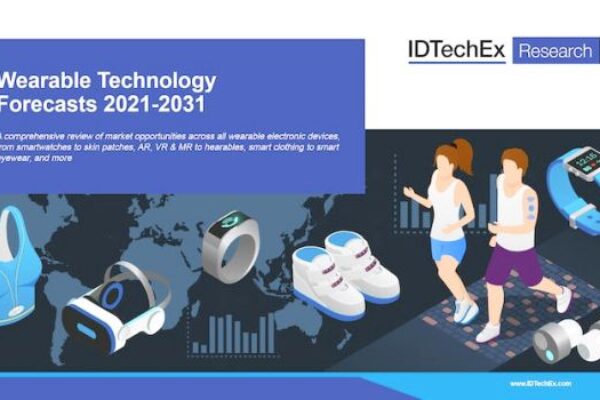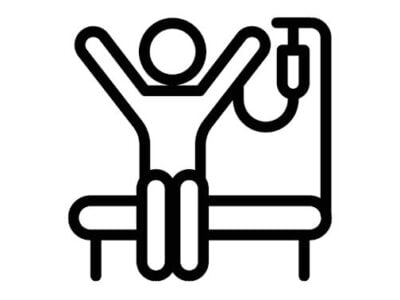
New analysis by market research firm IDTechEx finds that as the smartwatch market matures, the expanding capabilities of alternative wearables could begin tempting consumers away. Not only could these devices provide more value, says the firm, they also have the potential to access new biometrics.
Earphones: Listening to Emotions
Earphones have a fundamental advantage that wrist-wear does not – they are near the brain. The proximity of the ear to the brain could give more advanced earphones a commercial advantage in the coming years. Metal electrodes used to measure electric signals from the heart (ECG) can also measure neural activity (EEG).
Measurements of signals from the brain can quantify stress, sleep quality, and emotional state, as well as diagnose epilepsy. It is already possible to buy EEG-integrated headbands, but these are far less fashionable and mostly sold as a novelty toy. The challenge to date for an in-ear solution has been the miniaturization of electronics and noise cancellation.
In tandem, the demand for emotional state data is also growing. Advertisers are increasingly turning to EEG to access it. For example, it is now commonly used to assess viewer engagement with Super Bowl ads.
So far, big brands have refrained from adding new sensor technology into their hearables. It has long been possible to put optical heart-rate sensors into earphones, and while specific devices for sports are available, it has not found its way into the mass market. This is likely because the priority has been on enhancing audio quality. It is also because it provides a repeat data set available from the watch. Moreover, earphones cannot offer real-time data visualization.
However, says the firm, given their unique capability to interpret neural signals, now could be the time for hearables to play a more advanced role in the user-data collection via EEG.
Removable Pods and Performance Analytics
While smartwatches and fitness tracker bands currently dominate the activity monitoring market, demand for a more personalized approach could be on the horizon. Much of the value obtained from wearables is from the software analyzing user movements. However, the raw motion data available from a watch alone has limits, and the data analytics available from platforms created for athletes also has advantages for the mass market.
Hardware currently limits the use of watches during contact sports as it is too dangerous. Furthermore, motion detectable from the wrist is unable to capture specific movements associated with some sports very accurately — for example, weightlifting or body strength exercises. One solution proposed for the professional athlete market is the use of removable pods.
Removable pods can contain the same motion and hear-rate sensors found in smartwatches, but they are kept in place via pockets in chest straps, underwear, or trousers. It is now common to see premiere league footballers and NFL players wearing chest straps from Statsport or Kinexon. Similarly, professional golfers and cyclists are adopting Whoop bands which can be worn on the wrist or adapted for insertion into clothing.
For some companies, elite athletes have served as a marketing tool for their wearables. As such, the possibility for enhanced insights about stress and recovery, as well as the scope to use pods as well as wrist-wear, is beginning to reach a wider market. This trend is likely to continue in 2023, says the firm, especially given much of the value in this business model lies in the software.
This allows companies, such as Whoop, to offer a subscription to their platform, which includes the hardware. This could make it more affordable for the consumer market, who would value receiving upgraded hardware as a standard.
In the future, packages targeting amateur athletes and the broader wellness market will likely emerge. Consumers would value the opportunity to curate a more personalized approach to their fitness tracking, combining removable pods, watches, performance analytics, and data sharing to suit their needs.
Headsets and Eyewear
What lies beyond the smartwatch, says the firm, will largely be dictated by the future of users’ interaction with one another and the internet. Today, it is standard to use a laptop, smartphone, and possibly also a smartwatch for activity tracking and hands-free communication if desired. But this ecosystem has been the status quo for many years now and could be set for disruption.
The design of phones has stagnated in recent years and combined with ‘zoom fatigue’ following the pandemic, there are signs consumers are hungry for something more immersive. The development of augmented reality headsets and smart glasses could one day make the smartphone redundant, taking smartwatches with it. Wearable biometrics will likely follow if society switches to headgear for messaging, web browsing, and gaming.
AR/VR (augmented/virtual reality) headsets already need motion sensors and cameras for eye-tracking. Therefore, it is not hard to imagine the integration of dry electrodes across the forehead, collecting both heart rate data and measuring neural signals.
This kind of revolution is most likely to paint a picture of the world beyond the smartwatch. However, the success of this shift will be driven by advancements in display optics, which are still at least a few years away from reaching mass-market-ready levels of miniaturization. In the meantime, headgear and smart glasses need to become more socially accepted. As such, interim products (such as camera-integrated Ray Bans) will likely continue to be released to make them more fashionable. Similarly, gaming headsets are already seen in a growing number of TV advertisements. While they may look unsettling to some now, this time next year, society will likely be far more comfortable with them.
In conclusion, the ultimate hurdle facing earphones, removable pods, and headsets is balancing data access with visualization and social acceptance. The smartwatch is likely to follow the trajectory of the smartphone in becoming less impressive but continually in demand. The real opportunity is within the next generation of wearables, smartwatches will interface to satisfy the demand for new functionality. This market has much more room for new players, materials, and innovation.
 If you enjoyed this article, you will like the following ones: don't miss them by subscribing to :
eeNews on Google News
If you enjoyed this article, you will like the following ones: don't miss them by subscribing to :
eeNews on Google News




